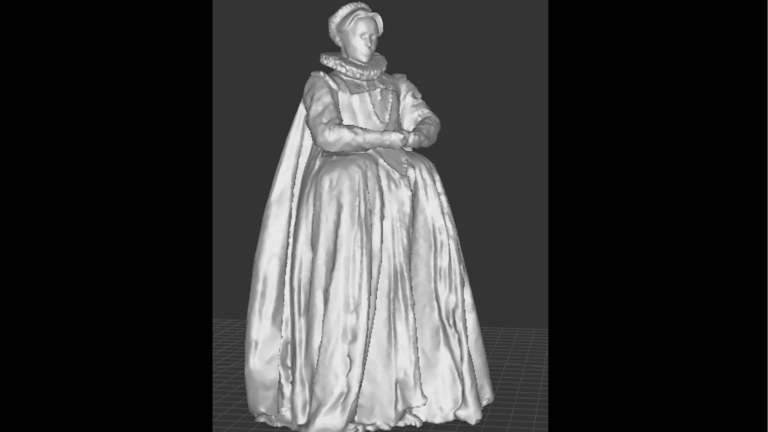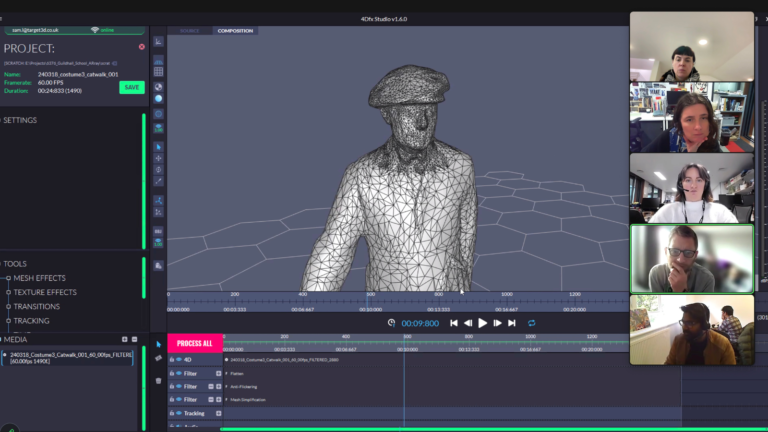
The ARray project was developed by Guildhall Production Studio, an externally facing design and production department of Guildhall School of Music & Drama that has been established to utilise the School’s creative resource for commercialisation and research. Working in collaboration with Angels Costumes and supported by virtual production studio Target3D, the ARray project was an exploration of how volumetric capture technology could inform the costume design process for theatre and other performance arts by prototyping a digital costume library. The tool enables designers to visualise and experiment with virtual costumes in a prototype platform that represents the physical costumes in a high-fidelity 3D format. ARray has been developed through the Follow on Funding for Impact and Engagement from the Arts & Humanities Research Council.
Other technical departments in a typical theatre pipeline (lighting, sound, video, set design, automation, props) all have powerful, commonplace digital design and previsualisation tools. However, during the COVID-19 lockdown, whilst developing online digital operas, it became apparent to the team at Guildhall School of Music & Drama that the costume department had less satisfactory digital means and process to support remote working and online collaboration. Costume was still a very hands-on, tactile department. Although the end product – costumed bodies on a stage - should remain that way, it seemed necessary to enable the creative process to be more integrated with, and supported by, a digital infrastructure.
By integrating this digital tool with established previsualisation technologies and enhancing collaborative workflows, ARray sought to modernise the operations of costume houses, streamline the costume selection process, and foster greater creativity and experimentation in costume design by making it faster, more accessible and more sustainable. It does this by allowing designers to view, manipulate and experiment with costumes in a virtual environment. By moving away from the reliance on physical prototypes, ARray seeks to enhance the efficiency, cost-effectiveness and creative potential of costume design.
We explored how digital tools could effectively replicate the tactile and dynamic aspects of costume materials, and how these tools could enhance the creative process by allowing for rapid prototyping and iteration. Additionally, we considered the practicalities of integrating such digital solutions into existing workflows in costume houses, examining how these technologies could support more collaborative practices in the burgeoning digital ecosystem. This involved assessing the impact of such technologies on traditional roles and processes within the industry, exploring how digital tools, and volumetric capture specifically, could support evolution of the costume design process while maintaining the artistry and detail that define the field.

In addition to Guildhall Production Studio, Angels Costume House and Target3D, the ARray project included contributions from academic researchers and technology experts working alongside a variety of industry professionals. This involved the merging of traditional costume design techniques with contemporary digital workflows, and also encouraged ongoing dialogue and knowledge exchange among academics, technology developers and industry professionals.
In terms of methodology, we employed a blend of qualitative and technological testing to develop and refine the digital costume library. Initial stages involved conversations, surveys and interviews with industry professionals.
Vanessa Lingham, Costume Lecturer on the BA (Hons) Production Arts Course at Guildhall had a pre-existing and extensive relationship with Angels. As designer, Vanessa created a narrative through costume for ARray, which focused on different key areas including the ruff, a full skirt, the black jacket and an apron. “By basing the design on these specific items of clothing, I was able to span the costume design over hundreds of years capturing the diverse range of fashion and dress available at Angels”, Vanessa said of the creative process.
Costumier Beth Gillman also assisted during the capture days and as a result identified the potential of volumetric capture for costumes, particularly uniforms, bridal wear and showcasing designers’ stock for clients abroad.
For the technical development, we used Guildhall’s Holosys Volumetric Capture Suite, which enabled precise motion capture of costumes in six degrees of freedom (6DoF). Its high-resolution imaging was essential for creating realistic digital models. These avatars were then further refined in 4DViews’ proprietary software 4DFX which allows for subtle refinements and corrections to the meshes that are then in turn taken into the Unreal game engine software to develop the final prototype that will be available online.
The Target3D team, with help from Head of Post Production, Sam Lawrence, oversaw the capture, which was engineered and facilitated by Guildhall Production Arts students. Sam made the following comment about the project: “ARay serves as a prime illustration of Holosys' capabilities, particularly in its ability to bring captured costumes to life. Curated meticulously by the remarkable costume department, Holosys flawlessly interprets these designs into the digital realm, avoiding the pitfalls of the uncanny valley.”
By addressing the need for digital transformation (or at least the need to keep pace with digital evolution) within the creative sectors the project has illustrated that with the right tools — and the right people — it is possible to evolve practices without eroding the analogue, tactile and embodied essence. ARray’s digital approach to costume design can streamline some aspects of the production process but also opens up new avenues for creativity, innovation and collaboration. It facilitates a deeper integration of technology in the arts, promoting sustainability by enhancing remote ways of working and reducing other temporal/physical constraints, allowing for more flexible, collaborative and inclusive design processes.
Academically, the project contributes to ongoing research in digital humanities by exploring how cutting-edge technologies can be adapted to enhance traditional artistic practices. Furthermore, it supports the preservation and accessibility of cultural heritage through its digital cataloguing capabilities, ensuring that valuable artistic resources are maintained and explored in dynamic new ways.
This project exemplifies how technology can be leveraged to foster growth and adaptation in the arts, reflecting broader trends towards digitalisation in cultural and academic institutions.
If you want to explore a potential future for costume design with ARray watch out for the upcoming release of the prototype that will appear through Guildhall Production Studio’s website — help us shape the next generation of costume design.
Top Image: Elizabeth 1st Costume Avatar / Elizabeth Landscape. Photo by Sam Lawrence
Middle Image: Development Session GPS. Photo by Leslie Deere
